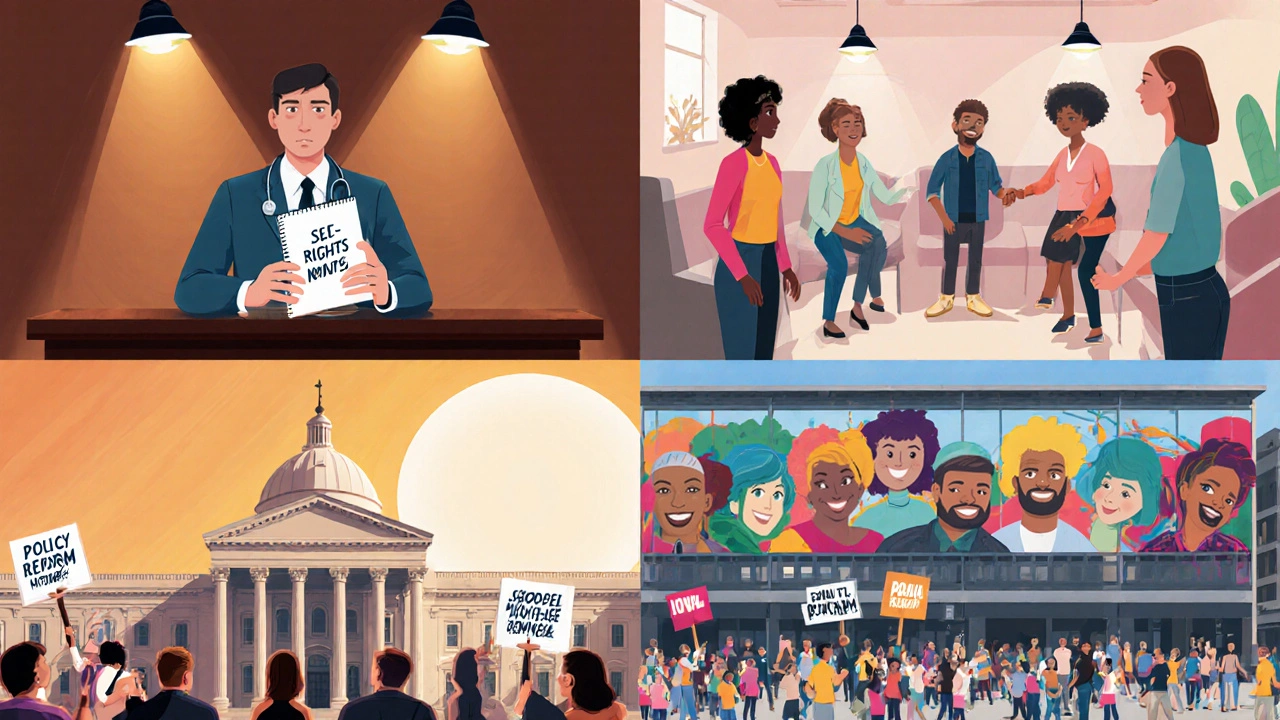Depressive Disorder Advocacy Explorer
Explore how different advocacy approaches can make a difference for people living with depressive disorder.
Self-Advocacy
Personal ImpactEmpower yourself to make informed decisions about your care and treatment.
Peer Support
Community ImpactConnect with others who understand your experience to build resilience.
Policy Reform
Societal ImpactInfluence laws and funding to improve mental health services system-wide.
Stigma Reduction
Broad ImpactChange public perception through storytelling and awareness campaigns.
Quick Advocacy Tips
- Start small: Educate yourself before taking action
- Use your voice: Share your story authentically
- Build networks: Connect with peers and professionals
- Stay informed: Know your legal rights
- Be consistent: Track your efforts and celebrate wins
Imagine waking up each day feeling invisible, while the world around you runs on assumptions about “depression.” That’s the reality for millions, and that’s why depressive disorder advocacy can be a game‑changer.
Advocacy for people with depressive disorder is the organized effort to protect rights, improve services, and challenge stigma for anyone living with clinical depression.Quick Takeaways
- Advocacy improves access to timely, evidence‑based treatment.
- Self‑advocacy empowers individuals to steer their own care.
- Peer support bridges gaps left by the health system.
- Policy change tackles systemic barriers and discrimination.
- Combining personal and community actions yields the biggest impact.
Understanding Depressive Disorder
Depressive disorder is a mood condition characterized by persistent sadness, loss of interest, and functional impairment lasting at least two weeks. The World Health Organization estimates that more than 280 million people worldwide are living with this condition, and nearly 40% of them never receive adequate treatment. This gap isn’t just about medication; it’s about a system that often overlooks the person behind the diagnosis.

Why Advocacy Is Critical
When people speak up, three things happen:
- Resources shift. Campaigns that highlight treatment gaps have led governments to fund new community clinics, reducing wait times by up to 30% in certain regions.
- Stigma fades. Public narratives that showcase recovery stories lower the odds of discrimination in workplaces by roughly 15% according to recent Australian surveys.
- Policy reforms emerge. Laws mandating mental‑health parity in insurance coverage were directly tied to advocacy coalitions that presented data to legislators.
Types of Advocacy
Advocacy isn’t one‑size‑fits‑all. Below is a quick comparison of the most common approaches.
| Type | Primary Goal | Typical Reach | Key Tactics |
|---|---|---|---|
| Self‑Advocacy | Empower individual decision‑making | Personal | Learning rights, medication dialogues, diary tracking |
| Peer Support | Build community resilience | Local‑to‑national | Support groups, mentorship, online forums |
| Policy Reform | Change laws and funding | Societal | Lobbying, public campaigns, research briefs |
| Stigma Reduction | Shift public perception | Broad | Media stories, celebrity endorsements, school curricula |
How to Advocate Effectively
Ready to take action? Follow these steps, each grounded in evidence and real‑world success.
- Educate yourself. Start with reliable sources-government mental‑health portals, peer‑reviewed journals, and organizations like beyondblue.
- Know your rights. In Australia, the National Disability Insurance Scheme (NDIS) provides funding for approved mental‑health supports. Familiarize yourself with eligibility criteria.
- Build a support network. Connect with peer support groups that meet weekly in community centres or online via platforms like 7 Cups. Sharing experiences reduces isolation by up to 25%.
- Craft a clear message. When meeting a clinician or policy maker, use a concise script: "I need a timely assessment, access to CBT, and continuity of care." Practice with a trusted friend.
- Leverage media. Write op‑eds, record short videos, or post personal stories using hashtags like #DepressionAdvocacy. Authentic narratives have a 3‑times higher share rate than statistics alone.
- Partner with professionals. Involve mental health professionals such as psychologists and psychiatrists who can lend credibility to your cause. Many are willing to speak at community events.
- Track progress. Keep a simple log of meetings, outcomes, and any policy changes. Data collection helps you refine tactics and demonstrate impact.

Common Pitfalls and How to Avoid Them
Even passionate advocates can stumble. Here’s what to watch out for:
- Over‑reliance on one channel. If you only post on social media, you miss policymakers who read briefing papers. Diversify your outreach.
- Neglecting self‑care. Burnout reduces effectiveness. Schedule regular downtime and seek professional help if symptoms worsen.
- Speaking in jargon. Complex language alienates allies. Keep wording plain and relatable.
- Assuming one solution fits all. Depressive disorder manifests differently across ages and cultures. Tailor messages to specific audiences.
Resources and Support Networks
Below are trusted resources you can tap into right now.
- Beyond Blue (Australia) - 24‑hour hotline, online chat, and self‑help tools.
- Headspace - Youth‑focused mental‑health services offering counseling and peer programmes.
- Australian Psychological Society (APS) - Directory of accredited psychologists and advocacy guides.
- National Disability Insurance Scheme (NDIS) - Funding portal for approved mental‑health supports.
- 7 Cups - Free, anonymous peer‑support chats available globally.
Frequently Asked Questions
How can I start self‑advocacy if I’m newly diagnosed?
Begin by writing down your symptoms, treatment goals, and any questions for your clinician. Bring this list to appointments, and ask for clarification on medication side effects, therapy options, and follow‑up plans. Use reputable websites to verify information, and consider joining a newcomer support group for shared tips.
What legal protections exist for people with depressive disorder in Australia?
The Disability Discrimination Act (1992) prohibits discrimination in employment, education, and public services based on mental health conditions. Additionally, the Fair Work Act safeguards against unfair dismissal, and the NDIS provides funding for approved supports.
Can advocacy really influence government policy?
Yes. In 2021, a coalition of mental‑health advocates presented a briefing to the Australian Senate, leading to the introduction of the National Mental Health Reform Bill, which allocated an extra $150million for community‑based services.
What are effective ways to reduce stigma in my workplace?
Organize short mental‑health awareness sessions, share factual infographics, and encourage leadership to openly discuss well‑being. Offer confidential employee‑assistance programs and ensure manager training includes how to support staff experiencing depression.
How do peer‑support groups differ from professional therapy?
Peer groups provide shared lived experience without clinical diagnosis, offering empathy and practical coping tips. Professional therapy delivers evidence‑based interventions, diagnostic assessment, and medication management. Both can complement each other for a fuller support system.


Dervla Rooney
Thank you for putting together such a comprehensive overview of advocacy. It is evident that self‑advocacy, peer support, policy reform and stigma reduction each play vital roles in improving the lives of individuals with depressive disorder. Your clear structure makes it easy for readers to identify actionable steps. I especially appreciate the emphasis on self‑education and the practical tips for articulating needs to clinicians. Such guidance empowers people to take charge of their own care while also fostering community resilience.